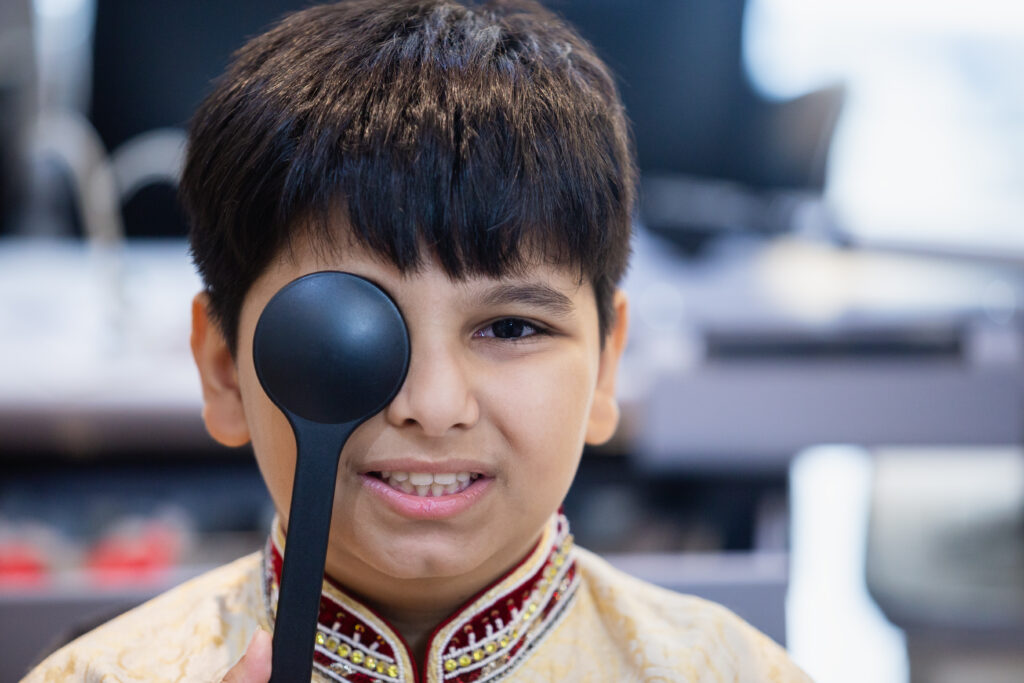
Amblyopia
What is Amblyopia?
Amblyopia, commonly known as Lazy Eye, is a vision development disorder that occurs when the brain and one of the eyes do not work together correctly. This results in reduced vision in the affected eye that cannot be fully corrected with glasses or contact lenses. Amblyopia is the leading cause of visual impairment in children and can persist into adulthood if left untreated.
What Causes Amblyopia?
Amblyopia develops when there is a problem with how the brain processes images from one or both eyes. The brain, preferring the clearer image from the stronger eye, may ignore or suppress the image from the weaker eye, leading to poor visual development in that eye. Several conditions can cause amblyopia, including:
- Strabismus (Crossed Eyes): A misalignment of the eyes where one eye turns inward, outward, upward, or downward, causing the brain to ignore the misaligned eye to avoid double vision.
- Refractive Errors: Significant differences in prescription strength between the two eyes (anisometropia) can cause amblyopia. The brain favors the eye with a clearer image.
- Deprivation Amblyopia: Caused by a problem that prevents light from entering the eye properly, such as a congenital cataract, droopy eyelid (ptosis), or other eye abnormalities.
Recognizing the Signs of Amblyopia
Amblyopia can be challenging to detect without a comprehensive eye examination, especially in young children who may not realize there is a problem with their vision. However, some common signs to watch for include:
- Poor Depth Perception: Difficulty judging distances or clumsiness.
- Eye Misalignment: One eye may appear to wander inwards or outwards.
- Squinting or Closing One Eye: A child may frequently squint or close one eye when trying to focus.
- Head Tilting: The child may tilt their head to see objects clearly.
- Favoring One Eye: A tendency to use one eye over the other.
If you notice any of these signs in your child, it is important to schedule a comprehensive eye exam at Sanjeevani Netralaya as early as possible.
Did You Know?
Amblyopia affects approximately 2-3% of children and can often go unnoticed without regular eye check-ups. Early detection and treatment are crucial for improving vision outcomes and preventing long-term visual impairment.
Diagnosis of Amblyopia
At Sanjeevani Netralaya, we use advanced diagnostic tools to accurately detect amblyopia and its underlying causes. Our comprehensive eye examination may include:
- Visual Acuity Test: To measure the sharpness of vision in each eye.
- Refraction Test: To determine if there is a difference in prescription strength between the eyes.
- Cover Test: To identify any eye misalignment (strabismus).
- Dilated Eye Exam: To check for any structural abnormalities like cataracts or retinal issues.
FAQs
Can amblyopia be treated in adults?
The Uvea is a vital layer of the eye composed of the iris, ciliary body, and choroid. It plays a keyWhile treatment is most effective in early childhood, some improvements in vision can still be achieved in adults with amblyopia through vision therapy and other interventions. role in regulating the amount of light that enters the eye and provides essential nutrients to the retina.
How long does amblyopia treatment take?
Treatment duration varies depending on the severity of the condition, the child’s age, and their response to therapy. Regular follow-ups are essential to monitor progress.
Can amblyopia come back after treatment?
In some cases, amblyopia may recur, especially if treatment is stopped too soon. Continuous follow-up care is crucial to maintaining visual improvement.
Is surgery always required for amblyopia?
Surgery is not always necessary and is typically reserved for cases where there is a structural abnormality, such as strabismus or cataracts, contributing to the amblyopia.

